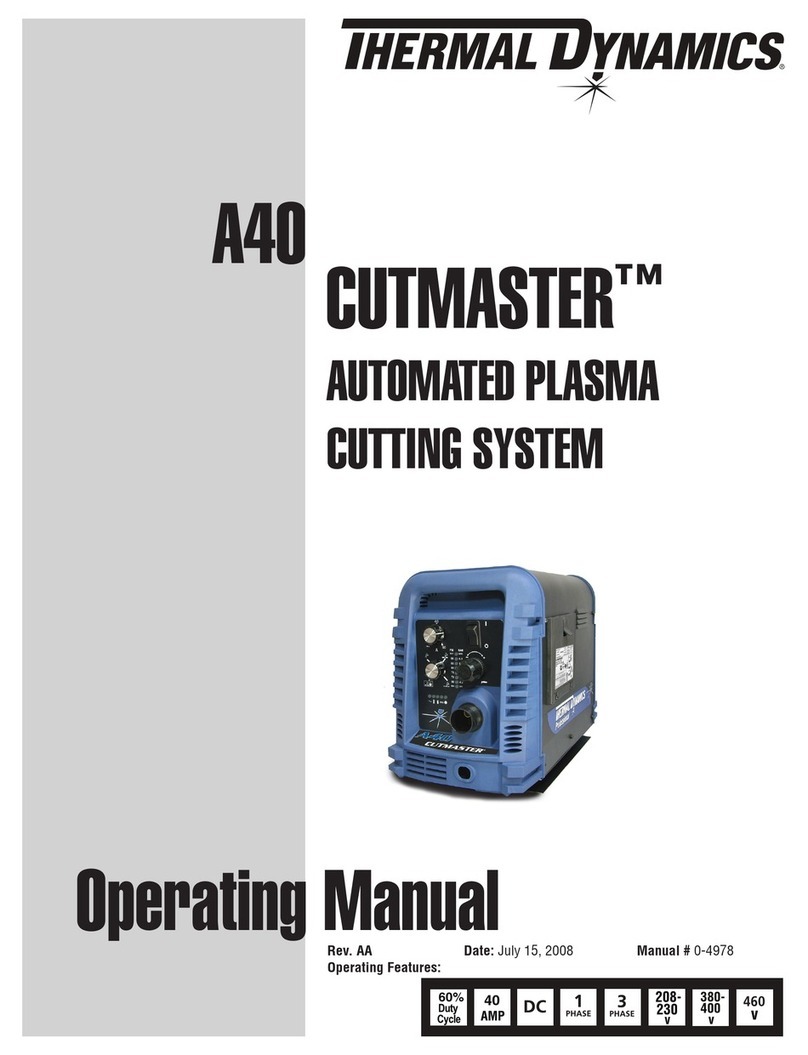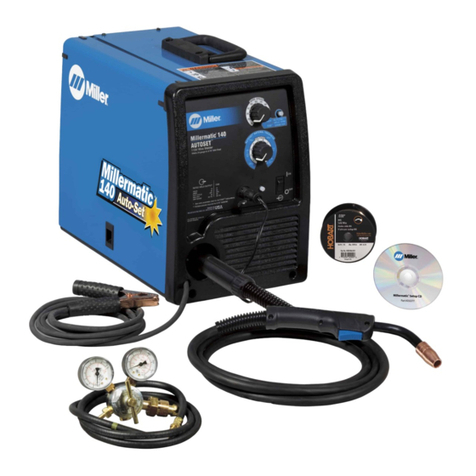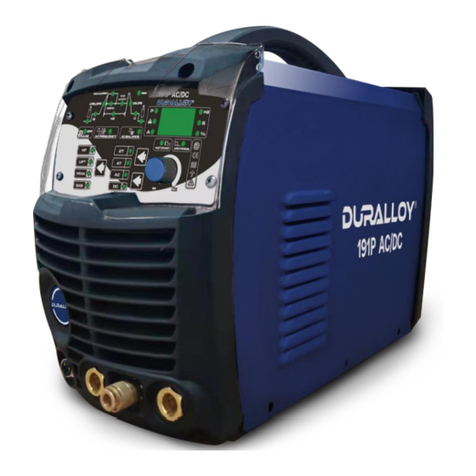Metalworks ARC 160 User manual

ARC160 - NLFREN - v1.0 - 03032014 ®
HANDLEIDING - MODE D’EMPLOI - MANUAL
ARC 160
(829650254)
Lastoestel
Poste à souder
Welding machine
P.02 Gelieve te lezen en voor later gebruik bewaren
P.08 Veuillez lire et conserver pour consultation ultérieure
P.14 Please read and keep for future reference
FR
EN
NL
copyrighted document - all rights reserved by FBC

ARC160 - NLFREN - v1.0 - 03032014
2
NL
®
1 Specicaties
Model ARC 160
Uitgangsstroom 150 A
Uitgangsspanning 230 V
Frequentie 50 Hz
Opgenomen vermogen 6,5 kW
Regelbereik 100 - 150 A
Isolatiegraad H
Lasdraad diameter 2,4 - 3,2 mm
Gewicht 16,5 kg
Afmetingen 1500 x 1150 x 353 mm
Inhoud
1 Specicaties �������������������������������������������������������������������������������������������� 2
2 Veiligheid ����������������������������������������������������������������������������������������������� 3
2.1 Elektrische aansluiting ..................................................................................... 3
2.2 Veiligheid tijdens het lassen.............................................................................. 3
3 Assemblage�������������������������������������������������������������������������������������������� 5
4 Gebruik �������������������������������������������������������������������������������������������������� 5
4.1 Instelknop ...................................................................................................... 5
4.2 Overbelastingsindicator................................................................................... 5
4.3 Lasproces....................................................................................................... 6
5 Onderhoud ��������������������������������������������������������������������������������������������� 7
6 Storingen������������������������������������������������������������������������������������������������ 7
7 EG conformiteitsverklaring �������������������������������������������������������������������� 20
copyrighted document - all rights reserved by FBC

ARC160 - NLFREN - v1.0 - 03032014
3
NL
®
AANDACHT! Het is de verantwoordelijkheid van de gebruiker de volgende voorschriften te
lezen, begrijpen en navolgen:
• Controleer de elektrische uitrusting en apparaten voor gebruik.
• Controleer de voedingskabels, stopcontacten en aansluitingen op slijtage en beschadiging.
• Zorg ervoor, dat het risico van elektrische schokken verminderd wordt door de installatie van geschikte
veiligheidsvoorzieningen. Een RCD (aardlekschakelaar) moet in de hoofdtabel geïntegreerd worden.
• Het gebruik van een stroomonderbreker wordt met alle elektrische apparaten aangeraden. Het is bijzonder
belangrijk een RCD te gebruiken met draagbare toestellen die op een stroomvoeding zonder GFCI bescherming
aangesloten zijn. Bij twijfel, neem contact op met een elektricien.
• Alle draagbare toestellen, die in commerciële gebouwen gebruikt worden, moeten tenminste eenmaal per maand
door een gekwaliceerde elektricien gecontroleerd worden.
• De eigenaar van een elektrisch toestel is verantwoordelijk voor de goede veiligheidstoestand van het toestel en van
de veiligheid van de gebruiker. In twijfelgeval, neem contact op met een elektricien.
• Verzeker u ervan, dat de kabels steeds beschermd worden tegen kortsluitingen en overbelasting.
• Controleer regelmatig de netsnoeren, stekker en aansluitingen op slijtage en beschadiging. Controleer dat de
aansluitingen goed vastzitten.
• Belangrijk: Verzeker u ervan, dat de spanning van het toestel dezelfde is als deze van de stroomvoeding, et dat de
stopcontacten van een gepaste zekering voorzien zijn. Voor sommige producten kan een 13 A stopcontact met een
zekering van minder dan 13 A uitgerust worden.
• Trek niet op het netsnoer om het toestel te verplaatsen of te heffen.
• Trek de stekker niet uit het stopcontact door op de kabel te trekken.
• Gebruik geen versleten of beschadigde kabels, stekkers of aansluitingen. Vervang deze onmiddellijk of laat ze door
een elektricien repareren.
2�2 Veiligheid tijdens het lassen
Netheid:
• Gebruik schone en droge perslucht om stof en vuil van de binnen- en buitenkant van het apparaat te blazen.
Verwijder vuil en afzettingen op de uiteinden van de klemmen. Voor een correcte ventilatie en koeling van
het apparaat, is het belangrijk dat de ventilatieopeningen vrij blijven.
• Controleer dat de kabel niet gestript is. Als de kabel gerafeld is, vervang deze dan voor gebruik.
• Houd de werkruimte schoon en goed verlicht. Een rommelige en donkere werkomgeving kan tot ongevallen
leiden. Houd de kinderen en onbevoegde mensen uit de werkruimte. Door verstrooidheid kunt u de controle
verliezen.
Beschermende kleding: Draag geschikte kleding tijdens het lassen:
• De mensen in de werkruimte moeten een lashelm en een oogbescherming dragen.
• Gebruik de geschikte beschermende masker met lter om de ogen, het gezicht, de nek et de oren tegen
vonken en straling van de boog te beschermen.
• De gebruiker mag niet direct naar de boog kijken en moet een veilige afstand van de straling en spatten
houden.
• Draag beschermende kleding, schoenen en masker als bescherming tegen de straling van de boog, spatten
en verstuivingen.
• Sluit alle knoppen om lichamelijk contact met vonken en spatten te voorkomen.
• Gebruik een brandwerende scheiding om de andere werknemers tegen straling en vonken te beschermen.
• Draag een veiligheidsbril bij de reiniging van spatten.
2 Veiligheid
2�1 Elektrische aansluiting
• Dit toestel moet geaard worden. Het moet in een stopcontact 230 V (50 Hz) met een nominale capaciteit van
meer dan 12 ampère aangesloten worden.
copyrighted document - all rights reserved by FBC

ARC160 - NLFREN - v1.0 - 03032014
4
NL
®
Brand en explosie: De hitte van het apparaat en de boog kan brand veroorzaken.
• Houd brandbare materialen zoals hout, stof, vloeibare brandstof en benzine weg van de werkruimte.
• De vloer en de wanden van de werkruimte moeten vrij van materiaal zijn om rook en brand te voorkomen.
• Zorg ervoor, dat de werkstukken schoon zijn voor het lassen, en las nooit op een afgesloten container.
• Brandblusapparaten moeten in de buurt van de werkruimte geplaatst worden.
• Gebruik het apparaat niet zodat deze overbelast is.
Elektrische schokken: Gebruik het lastoestel niet in een vochtige omgeving, om letsels en dood te voorkomen.
• Verzeker u ervan, dat het toestel goed geaard is.
• Zorg ervoor, dat het risico van elektrische schokken verminderd wordt door de installatie van geschikte
veiligheidsvoorzieningen. Een RCD (aardlekschakelaar) moet in de hoofdtabel geïntegreerd worden. Het
gebruik van een stroomonderbreker wordt met alle elektrische apparaten aangeraden. Het is bijzonder
belangrijk een RCD te gebruiken met draagbare toestellen die op een stroomvoeding zonder GFCI
bescherming aangesloten zijn. Bij twijfel, neem contact op met een elektricien.
• Houd de kleding, werkruimte, kabels, toorts, lasplaat en stroomvoeding droog.
• Houd het lichaam geïsoleerd van het werkstuk.
• De gebruiker moet op een droge houten plank of een isolerende platform staan als hij in een vochtige of
afgesloten ruimte werkt.
• Draag droge en gesloten handschoenen voordat u het apparaat inschakelt.
Elektromagnetisch veld: Werknemers met een pacemaker moeten hun arts raadplegen alvorens
laswerkzaamheden uit te voeren. Het elektromagnetische veld kan de werking van een pacemaker verstoren.
De werknemer moet de volgende voorzorgmaatregelen nemen om de blootstelling aan het elektromagnetische
veld te verminderen:
• Bind de klem van de electrode en de kabel samen. Een plakband kan gebruikt worden indien mogelijk.
• Wikkel de kabel van de lastoorts of werkkabel niet om u heen.
• Houd de kabel van de lastoorts en de werkkabel aan een kant van uzelf.
• Blijf zo ver mogelijk weg van de stroombron en laskabel.
Nevel en gas: Lasnevel en -gassen kunnen tot ongemak of ziekte leiden, vooral in een onvoldoende
geventileerde ruimte.
• Een natuurlijke of mechanische verluchter moet in de werkruimte geïnstalleerd worden. Las de volgende
metalen niet: gegalvaniseerd staal, koper, zink, beryllium en calcium. Adem geen nevels of gassen in.
• Las niet in de buurt van ontvetten of spuitwerkzaamheden, om giftige fosgeen of soortelijke gassen te
vermijden.
• Als u irritatie van ogen, neus, enz. voelt, stop dan onmiddellijk met lassen.
Onderhoud van het apparaat: Een onjuist of onvoldoende onderhoud van het apparaat kan ernstige letsels
of de dood veroorzaken.
• Alleen gekwaliceerd personeel kan de assemblage en het ouderhoud uitvoeren.
• Zorg ervoor, dat de kabel, aardingskabel, connector en stroomkabel in goede staat zijn.
• Hanteer altijd het apparaat en de accessoires correct.
• Berg het apparaat veilig op, en buiten het bereik van kinderen.
• Laat onbevoegde mensen het apparaat niet gebruiken. Elektrische gereedschappen zijn gevaarlijk in de
handen van onervaren gebruikers.
• Gebruik altijd de geschikte apparaten en accessoires.
OPERATORS’ MANUAL · TIG SERIES 2
1. SAFETY
Welding is dangerous, and may cause damage to you and others, so take good protection when welding. For
details, please refer to the operator safety guidelines in conformity with the accident prevention requirements of
the manufacturer.
Professional training is needed before operating the machine.
Use labor protection welding supplies authorized by national
security supervision department.
Operators should be with valid work permits for metal welding
(cutting) operations.
Cut off power before maintenance or repair.
Electric shock—may lead to serious injury or even death.
Install earth device according to the application criteria.
Never touch the live parts when skin bared or wearing wet
gloves/clothes.
Make sure that you are insulated from the ground and workpiece.
Make sure that your working position is safe.
Smoke & gas—may be harmful to health.
Keep your head away from smoke and gas to avoid inhalation of
exhaust gas from welding.
Keep the working environment well ventilated with exhaust or
ventilation equipment when welding.
Arc radiation—may damage eyes or burn skin.
Wear suitable welding masks and protective clothing to protect your
eyes and body.
Use suitable masks or screens to protect spectators from harm.
Improper operation may cause fire or explosion.
Welding sparks may result in a fire, so please make sure no
combustible materials nearby and pay attention to fire hazard.
Have a fire extinguisher nearby, and have a trained person to use it.
Airtight container welding is forbidden
Do not use this machine for pipe thawing.
Hot workpiece may cause severe scalding.
Do not touch hot workpiece with bare hands.
Cooling is needed during continuous use of the welding torch.
Noise may be harmful to people’s hearing.
Wear approved ear protection when welding.
Warn spectators that noise may be harmful to their hearing.
Magnetic fields affect cardiac pacemaker.
Pacemaker users should be away from the welding spot before
medical consultation.
OPERATORS’ MANUAL · TIG SERIES 2
1. SAFETY
Welding is dangerous, and may cause damage to you and others, so take good protection when welding. For
details, please refer to the operator safety guidelines in conformity with the accident prevention requirements of
the manufacturer.
Professional training is needed before operating the machine.
Use labor protection welding supplies authorized by national
security supervision department.
Operators should be with valid work permits for metal welding
(cutting) operations.
Cut off power before maintenance or repair.
Electric shock—may lead to serious injury or even death.
Install earth device according to the application criteria.
Never touch the live parts when skin bared or wearing wet
gloves/clothes.
Make sure that you are insulated from the ground and workpiece.
Make sure that your working position is safe.
Smoke & gas—may be harmful to health.
Keep your head away from smoke and gas to avoid inhalation of
exhaust gas from welding.
Keep the working environment well ventilated with exhaust or
ventilation equipment when welding.
Arc radiation—may damage eyes or burn skin.
Wear suitable welding masks and protective clothing to protect your
eyes and body.
Use suitable masks or screens to protect spectators from harm.
Improper operation may cause fire or explosion.
Welding sparks may result in a fire, so please make sure no
combustible materials nearby and pay attention to fire hazard.
Have a fire extinguisher nearby, and have a trained person to use it.
Airtight container welding is forbidden
Do not use this machine for pipe thawing.
Hot workpiece may cause severe scalding.
Do not touch hot workpiece with bare hands.
Cooling is needed during continuous use of the welding torch.
Noise may be harmful to people’s hearing.
Wear approved ear protection when welding.
Warn spectators that noise may be harmful to their hearing.
Magnetic fields affect cardiac pacemaker.
Pacemaker users should be away from the welding spot before
medical consultation.
copyrighted document - all rights reserved by FBC

ARC160 - NLFREN - v1.0 - 03032014
5
NL
®
3 Assemblage
Na het uitpakken van uw lastoestel, controleer het apparaat op transportschade
en waarschuw uw verdeler in geval van beschadigde of ontbrekende delen.
Verzeker u ervan, dat het verpakkingsmateriaal de ventilatieopeningen niet
verstopt.
Assemblage van de masker
Zie afbeelding 1 Afb. 1: Assemblage van de masker
4 Gebruik
4�1 Instelknop
Grootte van de lasdraad Regeling stroomsterkte
2,0 mm 60-70 A
2,5 mm 75-95 A
3,2 mm 100-140 A
4,0 mm 140-180 A
5,0 mm 190-250 A
4�2 Overbelastingsindicator
Als u met een hoge amperage voor een lange tijd last, en de inschakelduur overschrijdt, zal de indicator geel oplichten,
en het toestel zal stoppen totdat het weer een veilige temperatuur bereikt. Wanneer de overbelastingsindicator oplicht,
zet de schakelaar op OFF en wacht ongeveer 15 minuten voor het werk te hervatten.
copyrighted document - all rights reserved by FBC

ARC160 - NLFREN - v1.0 - 03032014
6
NL
®
4�3 Lasproces
1� Montage van de lasdraad
Kies de geschikte lasdraad en steek deze in de lasdraad houder. De lasdraad moet ongeveer dezelfde dikte hebben
als de te lassen werkstukken.
2� Voorbereiding van het werkstuk
Het deel dat gelast moet worden moet perfect schoon zijn. Coatings, bedekkingen of corrosie moeten verwijderd
worden, anders zal een goede las onmogelijk zijn.
3� Oververhittingsbeveiliging
Als de machine stopt en het oranje lampje op het voorpaneel brandt, dan is de oververhittingsbeveiliging
geactiveerd. Wacht tot de transformator voldoende afgekoeld is (het oranje lampje gaat uit) alvorens verder te
werken.
4� De aardeklem bevestigen
Bevestig de aardeklem stevig aan het werkstuk, zo dicht mogelijk van het laspunt.
IMPORTANT: Verzeker u ervan, dat de aardeklem op schone en stevig metaal bevestigd wordt. Reinig indien nodig
met een staalborstel of soortelijk om een goede verbinding te waarborgen.
5� De machine inschakelen
Selecteer de lasstroom door de schakelaar LOW / HIGH op het voorpaneel te draaien. Schakel de machine in door
op de knop ON te drukken.
6� De vlamboog ontsteken
AANDACHT: Voordat u de vlamboog ontsteekt, breng altijd de masker voor uw gezicht, om uw ogen te
beschermen.
a� Plaats de elektrode precies over de plek waar u de lasboog wilt ontsteken.
b� Plaats de maker voor uw gezicht, en stevig tik op de elektrode naar beneden. Zodra het contact gemaakt wordt,
moet u onmiddellijk de elektrode optillen, tot de gewenste booglengte.
• De booglengte moet ongeveer overeenkomen met de diameter van de elektrodekern.
•Als u de elektrode te ver brengt wanneer de boog ontstoken is, u zal de boog verliezen en opnieuw moeten
proberen.
OPMERKING : Het gebeurt dikwijls dat de elektrode aan het werkstuk kleeft. U kunt deze door een harde
slag losmaken. Als de elektrode niet gemakkelijk loskomt, schakel de machine onmiddellijk uit, anders zal deze
oververhitten. Geef dan een slag op de lasnaad met een bijtelhamer. Met de ervaring zal dit steeds minder
gebeuren.
c� Eens de boog ontstoken is, verplaats de elektrode langs de beoogde baan. Houd de tip van de elektrode constant
in het smeltbad.
• U moet u ook aan een regelmatige verplaatsing van de elektrode aanwennen.
• U moet een regelmatig krakend geluid horen, dit betekent dat het een goede las is.
d� Controleer het werk zorgvuldig. De lasplek moet een volledige versmelting van de elektrode en het basismetaal
zijn.
• Alle metaalslakken, die op het oppervlak ontstaan, moeten met de bijgeleverde hamer/borstel afgestoken worden.
• Als de resulterende lasnaad onregelmatig is, is dit een indicatie van porositeit of besmetting door slakken, en dat u
de juiste combinatie tussen snelheid en stroom niet bereikt heeft. Dit is een veel voorkomend probleem. Maak u maar
geen zorgen, omdat de praktijk dit snel zal oplossen.
copyrighted document - all rights reserved by FBC

ARC160 - NLFREN - v1.0 - 03032014
7
NL
®
5 Onderhoud
• Gebruik schone en droge lage druk perslucht om stof en vuil van de binnen- en buitenkant van het toestel te blazen.
Reinig het uiteinde van de lastoorts. De frequentie van de onderhoudswerkzaamheden is afhankelijk van de
gebruiksomstandigheden.
• Wanneer de spoel leeg is moet deze vervangen worden. U kunt draadspoelen bij uw verdeler vinden.
6 Storingen
Storing Oorzaak Oplossing
Geen stroom - Geen stroom op de stroomvoeding.
- Zekering of stroomonderbreker defect.
- Bescherming tegen overbelasting.
- Controleer de zekering en de
stroomonderbreker.
- Vervang de zekering of de
stroomonderbreker.
- Laat afkoelen en daarna hervat het werk
Te weinig stroom - De ingangsstroom is te laag.
- Verkeerde aansluiting.
- Een component werd beschadigd.
- Controleer of de ingangsstroom dezelfde is
als de nominale stroom.
- Controleer de massakabel op goede
aansluiting.
- Vervang de kabel.
Het toestel werkt niet
wanneer de schakelaar
bediend wordt
- De bedieningskabel is afgebroken.
- Printplaat beschadigd.
- Neem contact op met een elektricien.
- Vervang de printplaat.
De boog draagt niet over - Losse of ontbrekende aansluitingen in de
kabels.
- Controleer alle kabels en aansluitingen.
Belangrijk: ontkoppel eerst de hoofdkabel.
De boog is moeilijk te
ontsteken
- De toorts is verkeerd gemonteerd.
- Te lage spanning
- Controleer de assemblage en aansluiting
van de toorts.
- Houd de spanning zo stabiel mogelijk.
Als de spanning lager is dan de nominale
ingangsspanning:
1. De lasstroom is te laag.
2. De boog kan breken of onstabiel zijn.
Als de spanning hoger is dan de nominale
ingangsspanning:
1. De lasstroom is te hoog.
2. Dit zal lawaai maken.
3. Dit vermindert de levensduur van het
lastoestel.
copyrighted document - all rights reserved by FBC

8
®ARC160 - NLFREN - v1.0 - 03032014
FR
1 Spécications
Modèle ARC 160
Courant de sortie 150 A
Tension d’entrée 230 V
Fréquence 50 Hz
Puissance absorbée 6,5 kW
Plage de réglage 100 - 150 A
Degré d’isolation H
Diamètre l de soudage 2,4 - 3,2 mm
Poids 16,5 kg
Dimensions 1500 x 1150 x 353 mm
Table des matières
1 Spécications������������������������������������������������������������������������������������������ 8
2 Sécurité��������������������������������������������������������������������������������������������������� 9
2.1 Connexion électrique....................................................................................... 9
2.2 Consignes de sécurité pendant le travail ............................................................ 9
3 Assemblage�������������������������������������������������������������������������������������������11
4 Opération ����������������������������������������������������������������������������������������������11
4.1 Bouton de réglage........................................................................................ 11
4.2 Indicateur de surcharge ................................................................................. 11
4.3 Utilisation de l’appareil ................................................................................. 12
5 Entretien ����������������������������������������������������������������������������������������������� 13
6 Dysfonctionnements������������������������������������������������������������������������������ 13
7 Déclaration de conformité CE����������������������������������������������������������������� 20
copyrighted document - all rights reserved by FBC

9
®
ARC160 - NLFREN - v1.0 - 03032014
FR
ATTENTION! Il est de la responsabilité de l’utilisateur de lire, comprendre et respecter les
instructions suivantes :
• Avant utilisation, vériez l’installation et les appareils électriques.
• Vériez que les câbles d’alimentation, prises de courant et connexions ne sont pas usés ou endommagés.
• Assurez-vous que le risque d’électrocution est minimisé par l’installation de dispositifs de sécurité appropriés. Un
disjoncteur différentiel (disjoncteur courant résiduel) doit être intégré au tableau principal.
• Nous recommandons également l’utilisation d’un disjoncteur avec tous les appareils électriques. Il est
particulièrement important d’utiliser un disjoncteur différentiel avec les appareils portables branchés sur une
alimentation non protégée par un disjoncteur différentiel. En cas de doute, contactez un électricien.
• Vous pouvez obtenir un disjoncteur en contactant votre revendeur.
• Tous les appareils portables utilisés dans des locaux commerciaux doivent être vériés par un électricien qualié au
moins une fois par mois.
• Le propriétaire d’un appareil électrique est responsable du bon état de sécurité de l’appareil et de la sécurité de
l’utilisateur. En cas de doute sur la sécurité, contactez un électricien qualié.
• Vériez l’isolation de tous les câbles et la sécurité du produit avant de la brancher sur le secteur. Utilisez un testeur
d’appareils portables (PAT).
• Assurez-vous que les câbles sont toujours protégés contre les courts-circuits et les surcharges.
• Inspectez régulièrement les cordons d’alimentation, ches et toutes les connexions électriques pour voir s’il ne sont
pas usés ou endommagés. Vériez que les connexions sont bien serrées.
• Important: Assurez-vous que la tension indiquée sur l’appareil est le même que celui de l’alimentation électrique, et
que les prises sont équipées d’un fusible de capacité adéquate. Une prise de 13 A peut requérir un fusible de moins
de 13 A pour certains produits.
• Ne tirez pas ou ne levez pas l’appareil électrique par le câble d’alimentation.
• Ne débranchez pas la che en tirant sur le câble.
• N’utilisez pas de câbles, ches ou connexions usés ou endommagés. Remplacez-les immédiatement ou faites-les
réparer par un électricien.
2�2 Consignes de sécurité pendant le travail
Propreté :
• Utilisez de l’air propre et sec pour soufer la poussière et les saletés se trouvant à l’intérieur et à l’extérieur de
l’appareil. Nettoyez la saleté et les dépôts sur les extrémités des pinces. Pour assurer une bonne ventilation et
un refroidissement correct, il est important de laisser les volets d’aération de l’appareil bien dégagés.
• Vériez si l’isolation du câble est dénudée. Si le câble est efloché, remplacez-le avant utilisation.
• Gardez l’espace de travail propre et bien éclairé. Les endroits encombrés et sombres sont propices aux
accidents. Tenez les enfants et autres personnes non autorisées éloignées de l’espace de travail. La distraction
peut vous faire perdre le contrôle.
2 Sécurité
2�1 Connexion électrique
• Cet appareil doit être relié à la terre. Il doit être branché sur une prise 230 V (50 Hz) avec une capacité
nominale de plus de 12 ampères.
copyrighted document - all rights reserved by FBC

10
®ARC160 - NLFREN - v1.0 - 03032014
FR
Protections individuelles : Portez des vêtements appropriés pendant les opérations de soudage :
• Les personnes se trouvant dans l’espace de travail doivent porter un masque de soudage, une visière et des
lunettes de protection.
• Le masque de protection approprié avec ltre doit être utilisé pour protéger les yeux, le visage, le cou et les
oreilles des étincelles et du rayonnement de l’arc.
• L’utilisateur ne peut pas regarder directement l’arc et doit garder une distance de sécurité par rapport au
rayonnement de l’arc et aux éclaboussures.
• Les vêtements de protection, chaussures et masque doivent être portés pour protéger l’utilisateur du
rayonnement de l’arc, des pulvérisations et des éclaboussures.
• Tous les boutons doivent être fermés pour éviter le contact du corps avec des étincelles et des éclaboussures.
• Une séparation ininammable et un rideau doivent être utilisés pour protéger les autres travailleurs du
rayonnement et des étincelles.
• Des lunettes de protection doivent être portées lors du nettoyage des projections de soudure.
Incendie et explosion : La chaleur de l’appareil et de l’arc peut provoquer un incendie.
• Gardez les matériaux inammables tels que le bois, le tissu, les combustible liquides et essences loin de la
zone de travail.
• Le sol et les murs de l’espace de travail doivent être exempts de tout matériel an d’éviter la fumée et les
incendies.
• Assurez-vous que les pièces à usiner sont dégagées avant le soudage, et ne soudez jamais sur un conteneur
scellé.
• Les moyens de lutte contre l’incendie doivent être placés à proximité de la zone de travail.
• N’utilisez pas l’équipement de sorte qu’il soit en surcharge.
Chocs électriques : N’utilisez pas le poste à souder dans un environnement humide, pour éviter les blessures
ou la mort.
• Assurez-vous que le système est bien mis à la terre.
• Assurez-vous que le risque d’électrocution est minimisé par l’installation de dispositifs de sécurité
appropriés. Un disjoncteur différentiel (disjoncteur courant résiduel) doit être intégré au tableau principal.
Nous recommandons également l’utilisation d’un disjoncteur avec tous les appareils électriques. Il est
particulièrement important d’utiliser un disjoncteur différentiel avec les appareils portables branchés sur une
alimentation non protégée par un disjoncteur différentiel. En cas de doute, contactez un électricien.
• Conservez bien au sec les vêtements, la zone de travail, les câbles, la torche, la plaque de soudure et
l’alimentation électrique.
• Gardez le corps isolé de la pièce à usiner.
• L’opérateur doit se tenir sur une planche de bois sec ou une plate-forme isolante s’il travaille dans une zone
humide ou scellée.
• Des gants secs et fermés doivent être portés avant la mise sous tension.
Champ électromagnétique : Les travailleurs portant un stimulateur cardiaque doivent consulter leur médecin
avant d’effectuer des travaux de soudure. Le champ électromagnétique peut perturber le fonctionnement d’un
stimulateur cardiaque.
Le travailleur doit prendre les précautions suivantes pour diminuer l’exposition au champ électromagnétique :
• Mettez la cosse de l’électrode et le câble ensemble. Une bande adhésive peut être utilisée si possible.
• N’enroulez pas le câble de la torche de soudage ni le câble de travail autour de vous.
• Maintenez le câble de la torche de soudage et le câble de travail d’un côté de vous.
• Branchez le câble de travail à la pièce à usiner et allez dès que possible dans la zone de soudage.
• Tenez-vous autant que possible à l’écart de la source d’énergie et du câble de soudage.
OPERATORS’ MANUAL · TIG SERIES 2
1. SAFETY
Welding is dangerous, and may cause damage to you and others, so take good protection when welding. For
details, please refer to the operator safety guidelines in conformity with the accident prevention requirements of
the manufacturer.
Professional training is needed before operating the machine.
Use labor protection welding supplies authorized by national
security supervision department.
Operators should be with valid work permits for metal welding
(cutting) operations.
Cut off power before maintenance or repair.
Electric shock—may lead to serious injury or even death.
Install earth device according to the application criteria.
Never touch the live parts when skin bared or wearing wet
gloves/clothes.
Make sure that you are insulated from the ground and workpiece.
Make sure that your working position is safe.
Smoke & gas—may be harmful to health.
Keep your head away from smoke and gas to avoid inhalation of
exhaust gas from welding.
Keep the working environment well ventilated with exhaust or
ventilation equipment when welding.
Arc radiation—may damage eyes or burn skin.
Wear suitable welding masks and protective clothing to protect your
eyes and body.
Use suitable masks or screens to protect spectators from harm.
Improper operation may cause fire or explosion.
Welding sparks may result in a fire, so please make sure no
combustible materials nearby and pay attention to fire hazard.
Have a fire extinguisher nearby, and have a trained person to use it.
Airtight container welding is forbidden
Do not use this machine for pipe thawing.
Hot workpiece may cause severe scalding.
Do not touch hot workpiece with bare hands.
Cooling is needed during continuous use of the welding torch.
Noise may be harmful to people’s hearing.
Wear approved ear protection when welding.
Warn spectators that noise may be harmful to their hearing.
Magnetic fields affect cardiac pacemaker.
Pacemaker users should be away from the welding spot before
medical consultation.
copyrighted document - all rights reserved by FBC

11
®
ARC160 - NLFREN - v1.0 - 03032014
FR
Brouillard et gaz : Le brouillard et le gaz de soudage peut incommoder ou rendre malade l’opérateur, surtout
dans un espace mal ventilé.
• Un aérateur mécanique ou naturel doit être installé dans l’espace de travail. Ne soudez pas les métaux
suivants : acier inoxydable galvanisé, cuivre, zinc, béryllium et le calcium. N’inhalez pas les brouillards et
gaz de soudage.
• Ne soudez pas à proximité d’opérations de dégraissage ou de pulvérisation, pour éviter le phosgène toxique
ou gaz similaires.
• Si vous sentez une irritation des yeux, du nez, etc., arrêtez immédiatement le soudage.
Entretien de l’équipement : Un entretien inadéquat ou insufsant de l’équipement peut causer de graves
blessures, voire la mort.
• Seul du personnel autorisé peut effectuer les opérations d’assemblage et de maintenance.
• La source d’énergie doit être coupée pour effectuer les travaux de maintenance.
• Assurez-vous que le câble, le câble de masse, le connecteur et le câble d’alimentation et l’alimentation sont
en bon état.
• Manipulez toujours correctement l’équipement et les accessoires.
• Rangez le matériel de manière sûre et hors de portée des enfants.
• Ne laissez pas les personnes non familiarisées avec l’outil ou ce mode d’emploi utiliser l’appareil. Les outils
électriques sont dangereux dans les mains d’utilisateurs inexpérimentés.
• Utilisez toujours les accessoires et équipements appropriés.
OPERATORS’ MANUAL · TIG SERIES 2
1. SAFETY
Welding is dangerous, and may cause damage to you and others, so take good protection when welding. For
details, please refer to the operator safety guidelines in conformity with the accident prevention requirements of
the manufacturer.
Professional training is needed before operating the machine.
Use labor protection welding supplies authorized by national
security supervision department.
Operators should be with valid work permits for metal welding
(cutting) operations.
Cut off power before maintenance or repair.
Electric shock—may lead to serious injury or even death.
Install earth device according to the application criteria.
Never touch the live parts when skin bared or wearing wet
gloves/clothes.
Make sure that you are insulated from the ground and workpiece.
Make sure that your working position is safe.
Smoke & gas—may be harmful to health.
Keep your head away from smoke and gas to avoid inhalation of
exhaust gas from welding.
Keep the working environment well ventilated with exhaust or
ventilation equipment when welding.
Arc radiation—may damage eyes or burn skin.
Wear suitable welding masks and protective clothing to protect your
eyes and body.
Use suitable masks or screens to protect spectators from harm.
Improper operation may cause fire or explosion.
Welding sparks may result in a fire, so please make sure no
combustible materials nearby and pay attention to fire hazard.
Have a fire extinguisher nearby, and have a trained person to use it.
Airtight container welding is forbidden
Do not use this machine for pipe thawing.
Hot workpiece may cause severe scalding.
Do not touch hot workpiece with bare hands.
Cooling is needed during continuous use of the welding torch.
Noise may be harmful to people’s hearing.
Wear approved ear protection when welding.
Warn spectators that noise may be harmful to their hearing.
Magnetic fields affect cardiac pacemaker.
Pacemaker users should be away from the welding spot before
medical consultation.
3 Assemblage
Après déballage de votre nouveau poste à souder, vériez si l’équipement n’a
pas été endommagé pendant le transport et avertissez votre revendeur s’il y a
des pièces manquantes ou cassées. Assurez-vous que le matériau d’emballage
ne bouche pas une des aérations de l’appareil.
Assemblage du masque
Voir gure 1
Fig. 1: Assemblage du masque
4 Opération
4�1 Bouton de réglage
Taille du l de soudage Réglage du courant
2,0 mm 60-70 A
2,5 mm 75-95 A
3,2 mm 100-140 A
4,0 mm 140-180 A
5,0 mm 190-250 A
4�2 Indicateur de surcharge
Si vous soudez avec un ampérage élevé pendant longtemps et que vous excédez le cycle de service, l’indicateur
va s’allumer en jaune et l’appareil va s’arrêter jusqu’à ce qu’il ait à nouveau atteint une température sûre. Quand
l’indicateur de surcharge s’allume, mettez l’interrupteur sur OFF et attendez environ 15 minutes avant de reprendre le
travail.
copyrighted document - all rights reserved by FBC

12
®ARC160 - NLFREN - v1.0 - 03032014
FR
4�3 Utilisation de l’appareil
1� Montage de la tige de soudage
Sélectionnez la tige de soudage appropriée et insérez-la dans le support de tige de soudage. Elle doit être
approximativement de la même épaisseur que les pièces à souder.
2� Préparation de la pièce
La zone à souder doit être parfaitement propre. Tout revêtement ou traces de corrosion doivent être éliminés, sinon,
une bonne soudure sera impossible.
3� Protection thermique
Si l’appareil s’éteint et que le voyant orange s’allume sur le panneau avant, c’est que la protection thermique s’est
enclenchée. Attendez que le transformateur ait sufsamment refroidi (le voyant s’éteint) avant de poursuivre le travail.
4� Fixation de la pince de terre
Fixez la pince de terre fermement à la pièce à usiner, le plus près possible du point de soudure.
IMPORTANT : Assurez-vous que la pince de masse est xée sur du métal propre et solide. Si nécessaire, nettoyez
avec une brosse métallique ou similaire an de garantir une bonne connexion.
5� Mise en marche
Sélectionnez le courant de soudage en tournant l’interrupteur LOW / HIGH sur le panneau avant. Mettez l’appareil
en marche en appuyant sur ON.
6� Amorcer l’arc
ATTENTION : Avant d’amorcer l’arc, placez toujours le masque devant votre visage, pour protéger vos yeux.
a� Placez l’électrode exactement au-dessus de l’endroit où vous voulez amorcer l’arc.
b� Mettez votre masque devant votre visage et appuyez fermement l’électrode vers le bas. Une fois que le contact est
établi, vous devez instantanément relever l’électrode en fonction de l’arc requis.
• L’amplitude de l’arc doit être à peu près égal au diamètre de l’électrode.
• Si vous retirez l’arc trop loin une fois qu’il est amorcé, vous le perdrez et devrez recommencer.
REMARQUE : Il arrive souvent lors de l’amorçage de l’arc que l’électrode colle à la pièce. Vous pouvez la décoller
d’un coup sec. Si elle ne se décolle pas facilement, éteignez l’appareil immédiatement, sinon il va vite surchauffer.
Donnez ensuite un coup de marteau burineur sur le joint. Plus vous aurez de l’expérience, moins cela risque d’arriver.
c� Quand l’arc est amorçé, déplacez l’électrode le long de sa trajectoire, en gardant constamment la pointe dans le
bain de fusion.
• Vous devez également vous habituer à déplacer l’électrode de manière régulière.
• Un bruit de crépitement régulier doit apparaître, c’est le signe d’une bonne soudure.
d� Observez soigneusement le travail. La zone de soudure doit être une fusion totale de l’électrode et du métal de
base.
• Toute scorie qui se forme à la surface doit être éliminée avec le marteau/brosse fourni.
• Si la soudure obtenue semble irrégulière, c’est un signe de porosité ou de contamination par des scories, et vous
n’avez pas atteint la bonne combinaison entre la vitesse et le courant. Il s’agit d’un problème courant qui ne doit pas
vous inquiéter : la pratique va rapidement y remédier.
copyrighted document - all rights reserved by FBC

13
®
ARC160 - NLFREN - v1.0 - 03032014
FR
5 Entretien
• Utilisez de l’air comprimé à basse pression propre et sec pour soufer la poussière et les saletés à l’intérieur et à
l’extérieur de l’appareil. Nettoyez l’extrémité de la torche de soudage. La fréquence des nettoyages dépend des
conditions d’utilisation.
• Lorsque la bobine de l est vide, remplacez-la. Vous pouvez en trouver chez votre fournisseur.
6 Dysfonctionnements
Panne Cause Solution
Pas de courant - Pas de courant à l’alimentation.
- Fusible ou disjoncteur défectueux.
- Protection contre la surcharge.
- Contrôlez le fusible et le disjoncteur.
- Remplacez le fusible ou le disjoncteur.
- Laissez refroidir et ensuite reprenez le travail.
Pas assez de courant - Le courant d’entrée est trop faible.
- Mauvaise connexion.
- Un composant est endommagé.
- Vériez si le courant d’entrée est le même que
le courant nominal.
- Contrôlez le câble de masse et assurez-vous
qu’il est bien connecté.
- Remplacez-le.
L’appareil ne fonctionne
pas quand vous actionnez
l’interrupteur
- Le câble de commande est détaché
- Circuit imprimé endommagé.
- Contrôlez et remplacez le câble.
- Remplacez le circuit imprimé.
L’arc ne transfère pas - Connexions desserrées ou
manquantes dans les câbles.
- Vériez tous les câbles et connexions.
Important : Débranchez d’abord le câble
principal.
L’arc s’enamme difcilement - La torche est mal assemblée.
- Problème de tension trop basse.
- Vériez l’assemblage de la torche.
- Vériez si les électrodes et la connexion de la
torche.
- Gardez la tension la plus stable possible.
Si la tension est plus basse que la tension
d’entrée nominale :
1. Le courant de soudage est trop bas.
2. L’arc peut s’interrompre ou être instable.
Si la tension est plus haute que la tension
d’entrée nominale:
1. Le courant de soudage est trop haut.
2. Cela va faire du bruit.
3. Cela diminue la durée de vie du poste à
souder.
copyrighted document - all rights reserved by FBC

14
®ARC160 - NLFREN - v1.0 - 03032014
EN
1 Specications
Model ARC 160
Output current 150 A
Input voltage 230 V
Frequency 50 Hz
Input capacity 6.5 kW
Current range 100 - 150 A
Insulation grade H
Welding rod diameter 2.4 - 3.2 mm
Weight 16.5 kg
External size 1500 x 1150 x 353 mm
Contents
1 Specications���������������������������������������������������������������������������������������� 14
2 Safety��������������������������������������������������������������������������������������������������� 15
2.1 Electrical connexion ...................................................................................... 15
2.2 Safety precautions during operation ................................................................ 16
3 Assembling��������������������������������������������������������������������������������������������17
4 Operation ����������������������������������������������������������������������������������������������17
4.1 Adjustment switch ......................................................................................... 17
4.2 Overload light.............................................................................................. 18
4.3 Using the welder .......................................................................................... 18
5 Maintenance����������������������������������������������������������������������������������������� 19
6 Trouble shooting ����������������������������������������������������������������������������������� 19
7 EC declaration of conformity ����������������������������������������������������������������� 20
copyrighted document - all rights reserved by FBC

15
®
ARC160 - NLFREN - v1.0 - 03032014
EN
UK only: Ensure the unit is correctly earthed via a three pin plug.
1. Connect the green/yellow earth wire to the earth terminal ‘E’.
2. Connect the brown live wire to live terminal ‘L’.
3. Connect the blue neutral wire to the neutral terminal ‘N’.
4. After wiring, check that there are no bare wires, that all wires have been
correctly connected, that the cable external insulation extends beyond the
cable restraint and that the restraint is tight.
Fig. 1: UK plug wiring
WARNING! It is the user’s responsibility to read, understand and comply with the following:
• You must check all electrical equipment and appliances to ensure they are safe before using.
• You must inspect power supply leads, plugs and all electrical connections for wear and damage.
• You must ensure the risk of electric shock is minimised by the installation of appropriate safety devices. An RCCB
(Residual Current Circuit Breaker) should be incorporated in the main distribution board.
• We also recommend that an RCD (Residual Current Device) is used with all electrical products. It is particularly
important to use an RCD together with portable products that are plugged into an electrical supply not protected by
an RCCB. If in doubt consult a qualied electrician.
• You may obtain a Residual Current Device by contacting your dealer.
• The Electricity At Work Act 1989 requires all portable electrical appliances, if used on business premises, to be tested
by a qualied electrician, using a Portable Appliance Tester (PAT), at least once a year.
• The Health & Safety at Work Act 1974 makes owners of electrical appliances responsible for the safe condition of
the appliance, and the safety of the appliance operator. If in any doubt about electrical safety, contact a qualied
electrician.
• Ensure the insulation on all cables and the product itself is safe before connecting to the mains power supply. Use a
Portable Appliance Tester (PAT).
• Ensure that cables are always protected against short circuit and overload.
• Regularly inspect power supply leads, plugs and all electrical connections for wear and damage and especially
power connections, to ensure that none is loose.
• Important: Ensure the voltage marked on the product is the same as the electrical power supply to be used and
check that plugs are tted with the correct capacity fuse. A 13 amp plug may require a fuse smaller than 13 amps
for certain products.
• Do not pull or carry the powered appliance by its power supply lead.
• Do not pull power plugs from sockets by the power cable.
• Do not use worn or damage leads, plugs or connections. Immediately replace or have repaired by a qualied
electrician.
2 Safety
2�1 Electrical connexion
• This machine must be earthed. This welder must be connected to a 230 V (50 Hz) supply, having a rated
capacity of greater than 12 amps.
• A 13 amp (BS1363) plug is not supplied for this device. Connect the three core mains leads to a suitably fused
supply through an isolator and heavy duty plug.
copyrighted document - all rights reserved by FBC

16
®ARC160 - NLFREN - v1.0 - 03032014
EN
2�2 Safety precautions during operation
Cleanliness:
• Use clean and dry low-pressure air to blow dust and dirt from the outer shell and interior. Clean the dirt,
dregs and grime from the head of welding tongs. In order to ensure enough circulating air and provide
proper cooling, it is necessary to keep the airways on the machine clear.
• Check if the insulation of cable has been frayed, if the cable has become frayed, you must replace it before
use.
• Keep work area clean and well lit. Cluttered and dark areas invite accidents. Keep children and bystanders
away while operating a power tool. Distractions can cause you to lose control.
Protective clothing: Please wear the appropriate protective clothing when welding:
• A welding helmet, face shield and protective goggles must be worn when in the working area.
• The appropriate face shield with lter and skin face shall be used to protect eyes, face, neck, and ears from
electrical spark and the arc ray.
• The user should not directly watch the arc and must also keep a safe distance away from the arc ray and
splash.
• The appropriate protective clothing, shoes and helmet shall be worn to protect from arc ray, spraying and
splattering.
• All the buttons shall be done up to avoid the sparking and splattering from coming into contact with the body.
• A non-ammable partition and door curtain shall be used to protect other workers from the electric ray and
sparking.
• Protective goggles must be worn when cleaning welding spatter.
Fire and explosion: The heat of frame and arc can cause re.
• Keep the ammable materials including wood, cloth, liquid fuel and petrol etc. away from the welding
working area.
• All the walls and oor in the working area should be free of any material in order to avoid smouldering and
re.
• Ensure that all the working pieces are cleared before welding, and do not do weld on a sealed container.
• Fire-ghting equipment should be positioned near the welding working area.
• Do not use the equipment such that it overloads.
Electric shock: Please do not use the welding source in the wet or wet areas to avoid any injury or death.
• Ensure the source underpan and earthing system of the input source is connected.
• You must ensure the risk of electric shock is minimised by the installation of appropriate safety devices.
An RCCB (Residual Current Circuit Breaker) should be incorporated in the main distribution board. We
also recommend that an RCD (Residual Current Device) is used with all electrical products. It is particularly
important to use an RCD together with portable products that are plugged into an electrical supply not
protected by an RCCB. If in doubt consult a qualied electrician.
• Always change the damaged or scuffed cable before using the machine.
• Keep dry, including any cloth, working area, wire, welding torch, soldering turret and power supply.
• Keep the body insulated from the work piece.
• The operator should stand on a dry wooden board or insulating platform of rubble shoes when working in a
sealed on moist area.
• Dry and sealed gloves should be worn before turning on the power.
copyrighted document - all rights reserved by FBC

17
®
ARC160 - NLFREN - v1.0 - 03032014
EN
Electromagnetic eld: Any workers with a heart pacemaker must consult with their doctor before doing
welding. The electromagnetic eld may disturb the normal work of a pacemaker.
A worker shall take the following measures to down times and exposing themselves to the electromagnetic eld:
• Put the electrode cause and work cable together, and also the tape can be used if possible.
• Do not wind the welding torch cable and work cable round yourself.
• Keep the welding torch cable and work cable to one side of yourself.
• Connect the work cable to the work piece, and make it to the welding area as soon as possible.
• Keep away from welding source and cable as much as possible.
Fog and gas: The welding fog and gas can make the worker uncomfortable or ill, especially in the limited/
poorly ventilated spaces.
• The aerator natural or mechanical shall be prepared in the working area. Do not weld on the following
metals: galvanized, stainless steel, copper, zinc, read, beryllium or calcium. Also do not breathe the welding
fog and gas in.
• Does not weld near the degreasing or spraying operation to avoid the poisonous gas phosgene or other
imitate gas.
• If you feel irritation to the eyes, nose, etc, stop welding at once.
Equipment maintenance: The wrong or inappropriate equipment maintenance can cause injury or death.
• Only licensed people should undertake assembly, maintenance and similar operations.
• The power source should be turned off when any maintenance work is needed.
• Ensure that the cable, earth wire, connector, main lead and power supply are in the normal conditions.
• Do not abuse equipment and accessories.
• Store the equipment safely out of the reach of children.
• Do not allow persons unfamiliar with the power tool or these instructions to operate the power tool. Power
tools are dangerous in the hands of untrained users.
• Always use the correct accessories and equipment.
OPERATORS’ MANUAL · TIG SERIES 2
1. SAFETY
Welding is dangerous, and may cause damage to you and others, so take good protection when welding. For
details, please refer to the operator safety guidelines in conformity with the accident prevention requirements of
the manufacturer.
Professional training is needed before operating the machine.
Use labor protection welding supplies authorized by national
security supervision department.
Operators should be with valid work permits for metal welding
(cutting) operations.
Cut off power before maintenance or repair.
Electric shock—may lead to serious injury or even death.
Install earth device according to the application criteria.
Never touch the live parts when skin bared or wearing wet
gloves/clothes.
Make sure that you are insulated from the ground and workpiece.
Make sure that your working position is safe.
Smoke & gas—may be harmful to health.
Keep your head away from smoke and gas to avoid inhalation of
exhaust gas from welding.
Keep the working environment well ventilated with exhaust or
ventilation equipment when welding.
Arc radiation—may damage eyes or burn skin.
Wear suitable welding masks and protective clothing to protect your
eyes and body.
Use suitable masks or screens to protect spectators from harm.
Improper operation may cause fire or explosion.
Welding sparks may result in a fire, so please make sure no
combustible materials nearby and pay attention to fire hazard.
Have a fire extinguisher nearby, and have a trained person to use it.
Airtight container welding is forbidden
Do not use this machine for pipe thawing.
Hot workpiece may cause severe scalding.
Do not touch hot workpiece with bare hands.
Cooling is needed during continuous use of the welding torch.
Noise may be harmful to people’s hearing.
Wear approved ear protection when welding.
Warn spectators that noise may be harmful to their hearing.
Magnetic fields affect cardiac pacemaker.
Pacemaker users should be away from the welding spot before
medical consultation.
OPERATORS’ MANUAL · TIG SERIES 2
1. SAFETY
Welding is dangerous, and may cause damage to you and others, so take good protection when welding. For
details, please refer to the operator safety guidelines in conformity with the accident prevention requirements of
the manufacturer.
Professional training is needed before operating the machine.
Use labor protection welding supplies authorized by national
security supervision department.
Operators should be with valid work permits for metal welding
(cutting) operations.
Cut off power before maintenance or repair.
Electric shock—may lead to serious injury or even death.
Install earth device according to the application criteria.
Never touch the live parts when skin bared or wearing wet
gloves/clothes.
Make sure that you are insulated from the ground and workpiece.
Make sure that your working position is safe.
Smoke & gas—may be harmful to health.
Keep your head away from smoke and gas to avoid inhalation of
exhaust gas from welding.
Keep the working environment well ventilated with exhaust or
ventilation equipment when welding.
Arc radiation—may damage eyes or burn skin.
Wear suitable welding masks and protective clothing to protect your
eyes and body.
Use suitable masks or screens to protect spectators from harm.
Improper operation may cause fire or explosion.
Welding sparks may result in a fire, so please make sure no
combustible materials nearby and pay attention to fire hazard.
Have a fire extinguisher nearby, and have a trained person to use it.
Airtight container welding is forbidden
Do not use this machine for pipe thawing.
Hot workpiece may cause severe scalding.
Do not touch hot workpiece with bare hands.
Cooling is needed during continuous use of the welding torch.
Noise may be harmful to people’s hearing.
Wear approved ear protection when welding.
Warn spectators that noise may be harmful to their hearing.
Magnetic fields affect cardiac pacemaker.
Pacemaker users should be away from the welding spot before
medical consultation.
3 Assembling
After unpacking your new welder you should check if the equipment has been
damaged during transit and notify your dealer if there are any missing or
broken parts. Ensure that the packing material is not blocking any air ways in
the welder.
Fixing the face shield
See gure 2
Fig. 2: Fixing the face shield
4 Operation
4�1 Adjustment switch
Size of welding rod Amperage setting
2.0 mm 60-70 A
2.5 mm 75-95 A
3.2 mm 100-140 A
4.0 mm 140-180 A
5.0 mm 190-250 A
copyrighted document - all rights reserved by FBC

18
®ARC160 - NLFREN - v1.0 - 03032014
EN
4�2 Overload light
If welding with large current for a long time and you exceed the duty cycle, the overload lamp will light yellow and the
machine will stop working until it once again reaches a safe temperature. When the overload lamp lights you must turn
the switch to OFF position and wait about 15 minutes, then you can continue.
4�3 Using the welder
1� Fitting the welding rod
Select the appropriate welding rod, and insert it into the welding rod holder. It should be approximately the same
thickness as the workpieces being welded.
2� Preparing the workpiece
The area being welded should be perfectly clean. Any coating, plating or corrosion must be removed, otherwise a
good weld will be impossible to achieve.
3� Thermal cutout
If the machine stops at any time and the amber light on the front panel illuminates, the thermal cutout has activated.
Wait until the transformer has cooled sufciently(the amber light goes out) before restarting work.
4� Attaching the earth clamp
Attach the earth clamp rmly to the workpiece as close as possible to the point of weld.
IMPORTANT: Ensure that the earth clamp is attached to clean, solid metal. If necessary, thoroughly clean with a
wire brush or similar to guarantee a good connection.
5� Switching ON
Select the welding current step by turning switch LOW/HIGH on the front panel. Switch ON the machine
6� Striking an arc
IMPORTANT: BEFORE you strike an arc, always bring the face shield up to protect your eyes.
a� Line up the electrode exactly over the spot where you want to strike.
b� Position your shield in front of your face and tap the electrode down rmly. Once you tap down and contact is
made, you must instantly raise the electrode to the required arc gap.
•The arc gap should be roughly the same as the diameter of the electrode.
•If you withdraw the electrode too far once the arc is struck, you will lose the arc and have to try again.
NOTE: One thing that usually happens when you are striking an arc is that the electrode sticks to the work. It should
come unstuck with a sharp tug. If it will not free easily, turn off the welder immediately as it will quickly overheat, then
give the join a tap from the chipping hammer. As you get more experienced, this will happen less.
c� Once the arc is struck, move the electrode along its intended path, keeping the tip in the molten pool at all times.
• You must also get used to feeding down the electrode steadily as it burns away.
• An even crackling noise should be heard, which is an indication of a good weld.
d� Inspect the job carefully, the area of weld should be complete fusion of the electrode and parent metal(s).
• Any slag which forms on the surface should be chipped away with the hammer/brush supplied.
•If the resultant weld looks messy and irregular, this is an indication of porosity or slag contamination, and you have
almost certainly failed to achieve the correct combination of speed and current. This is a common problem, so do not
worry as practice will quickly cure this.
copyrighted document - all rights reserved by FBC

19
®
ARC160 - NLFREN - v1.0 - 03032014
EN
5 Maintenance
• Use clean and dry, low-pressure air to blow dust and dirt from the outer parts of the unit and torch. Clear the dirt,
dregs and grime from the head of welding torch.
• When the wire on the feed reel is used up, you will need to replace it. You can purchase replacement wire from your
supplier.
6 Trouble shooting
Trouble Cause Solution
Without output - Without voltage in input terminal.
- Improper fuse or breaker.
- Overload protective setting.
- Check the fuse or breaker.
- Replace fuse or breaker.
- After cooling then try to continue.
Current is too poor - Input voltage is too poor.
- Bad connection.
- One or more commute element have
been damaged.
- Check that if input voltage is the same with
rated voltage.
- Check grounding cable and make sure have
well connection.
- Replace.
After turning on the
welder does not work
- Control wire broken off.
- Circuit plate damaged.
- Check and replace.
- Replace circuit plate.
Arc does not transfer - Loose of missing connections in the
cables.
- Check all cables and plugs.
Important: unplug at the mains rst.
Difculty in arc starting - Torch assembled incorrectly.
- Low voltage problems.
- Check torch assembly.
- Check electrodes and nozzles for blockage or
damage.
- Keep the voltage as stable as possible.
If the voltage is lower than rated input voltage:
1. The welding current is too low.
2. The arc may break or be unstable.
If the voltage is higher than rated input voltage:
1. The welding current is too high.
2. It will make noise.
4. It shortens the service life of welder.
copyrighted document - all rights reserved by FBC

ARC160 - NLFREN - v1.0 - 03032014
20
®
Fabrikant/Invoerder
Fabricant/Importateur
Manufacturer/Retailer
Verklaart hierbij dat het volgende product :
Déclare par ceci que le produit suivant :
Hereby declares that the following product :
Product
Produit
Product
Lastoestel
Poste à souder
Welding machine
Order nr. :
Geldende CE-richtlijnen
Normes CE en vigueur
Relevant EU directives
2004/108/EC
EN 60975-10:2007
EN 60974-10:2003
2006/95/EC
EN 60974-1:2005
EN 60974-1:2012
Overeenstemt met de bestemming van de hierboven aangeduide richtlijnen - met inbegrip van deze betreffende
het tijdstip van de verklaring der geldende veranderingen.
Répond aux normes générales caractérisées plus haut, y compris celles dont la date correspond aux modications
en vigueur.
Meets the provisions of the aforementioned directive, including, any amendments valid at the time of this
statement.
Bart Vynckier, Director
VYNCKIER TOOLS NV
Vynckier Tools nv/sa
Avenue Patrick Wagnonlaan, 7
ZAEM de Haureu
B-7700 Mouscron - Moeskroen
EG conformiteitsverklaring
Déclaration de conformité CE
EC declaration of conformity
ARC 160 (829650254)
FR
EN
NL
Moeskroen/Mouscron, 03-03-2014
7
copyrighted document - all rights reserved by FBC
Table of contents
Languages:
Other Metalworks Welding System manuals
Popular Welding System manuals by other brands

Miller Electric
Miller Electric SRH-444 Specifications
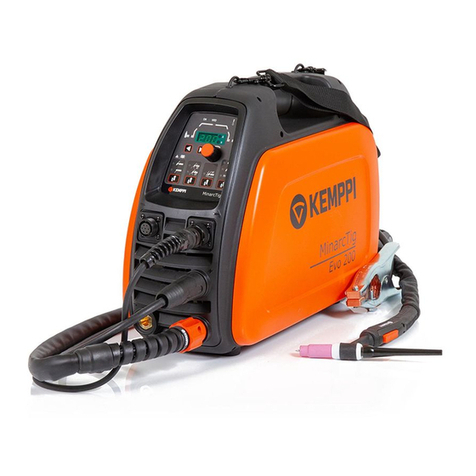
Kemppi
Kemppi MinarcTig Evo 200 Service manual

Eastwood
Eastwood MIG 175 Assembly & operating instructions
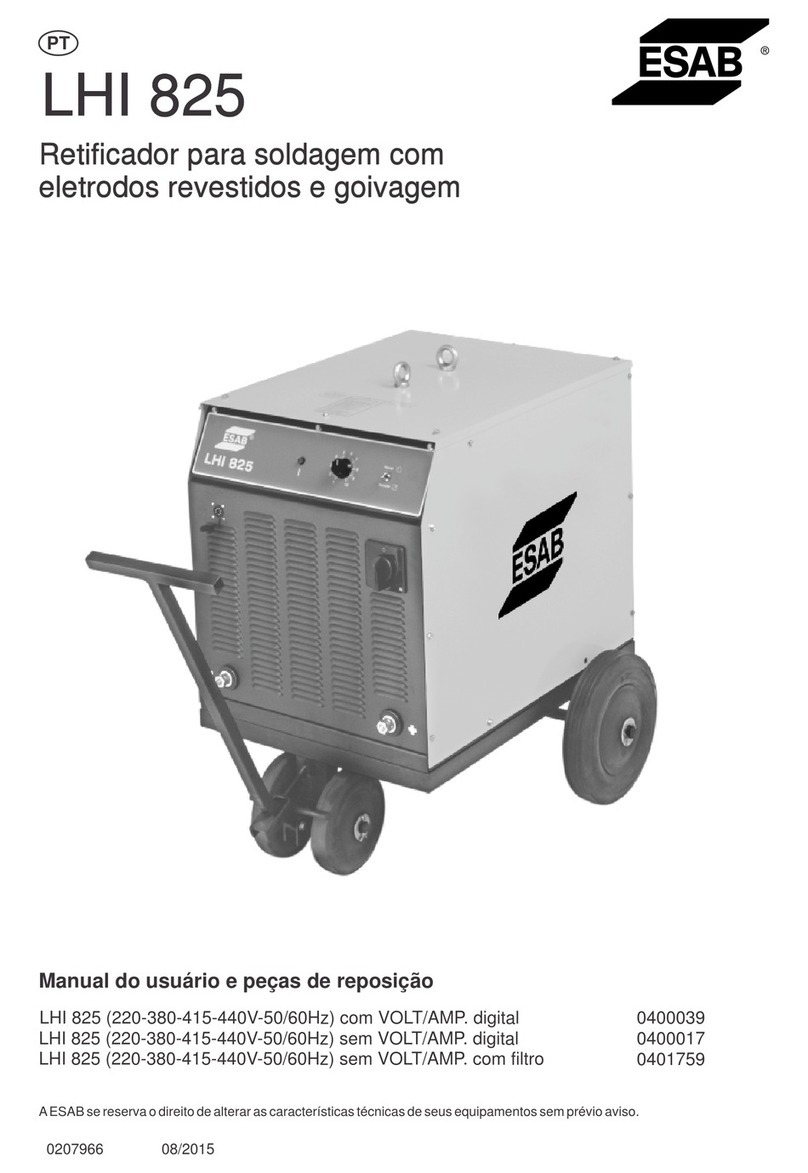
ESAB
ESAB LHI 825 Instruction manual and spare parts list
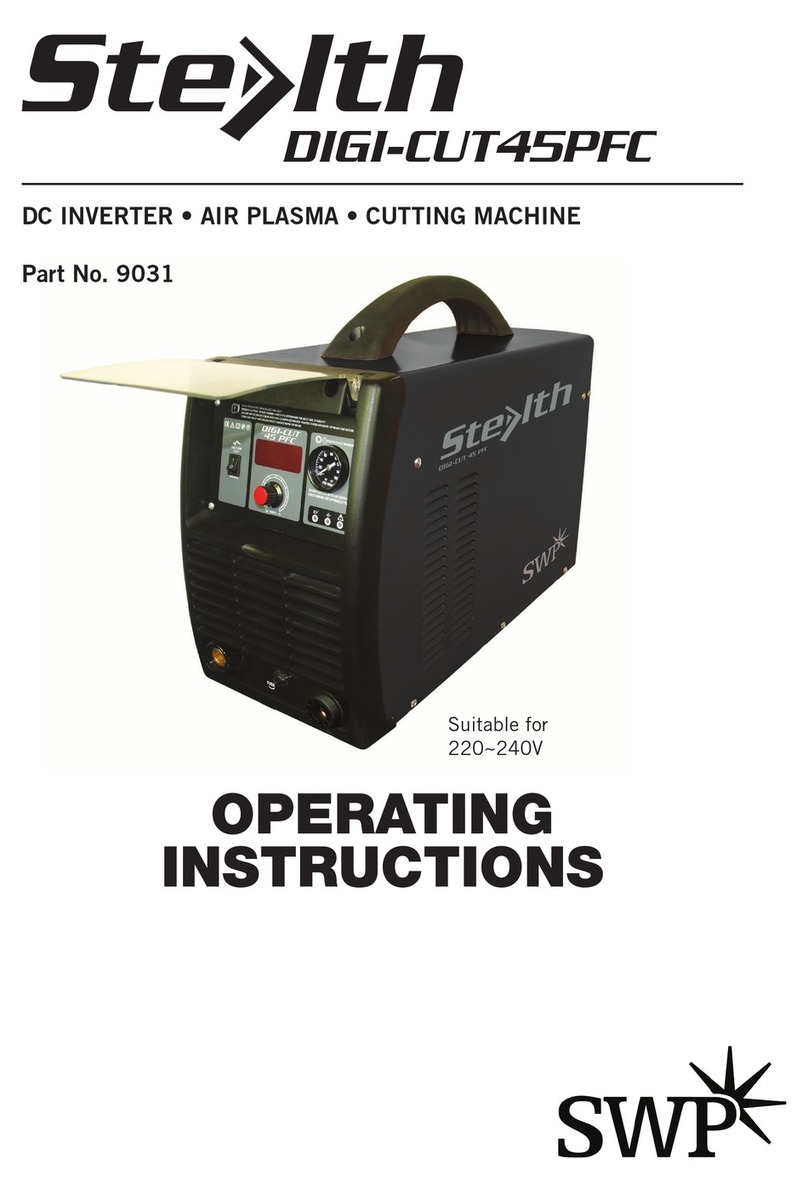
Stealth
Stealth digi-cut45pfc operating instructions
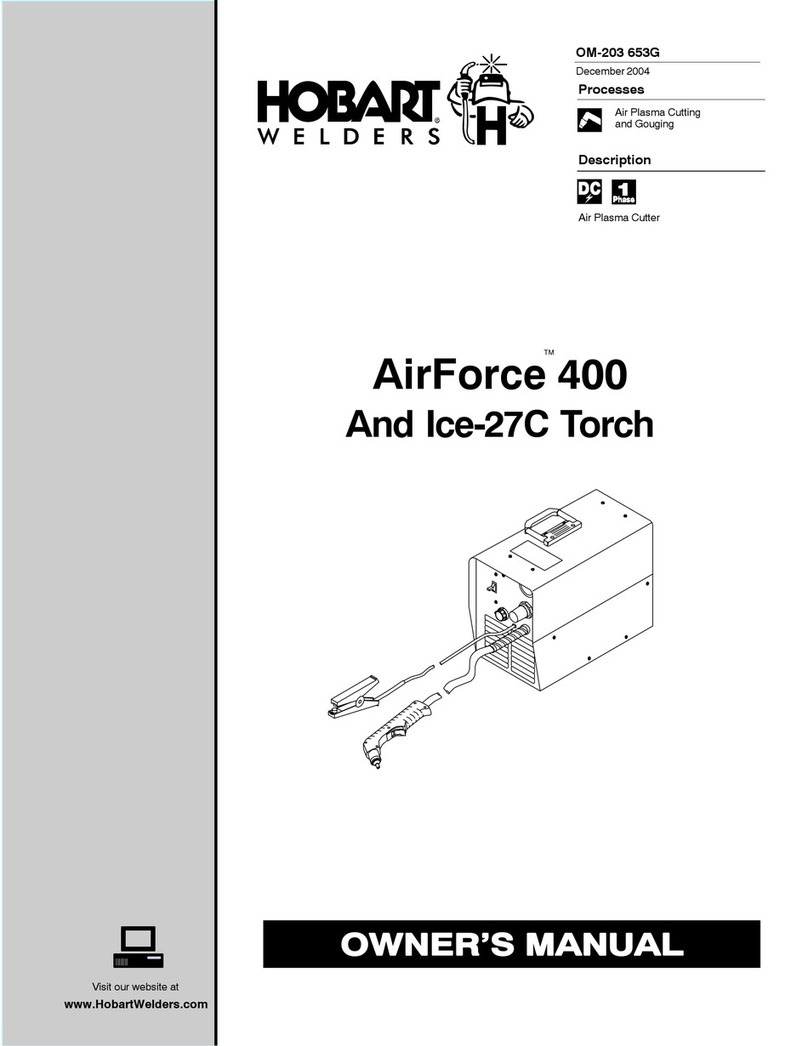
Hobart Welding Products
Hobart Welding Products AirForce 400 owner's manual
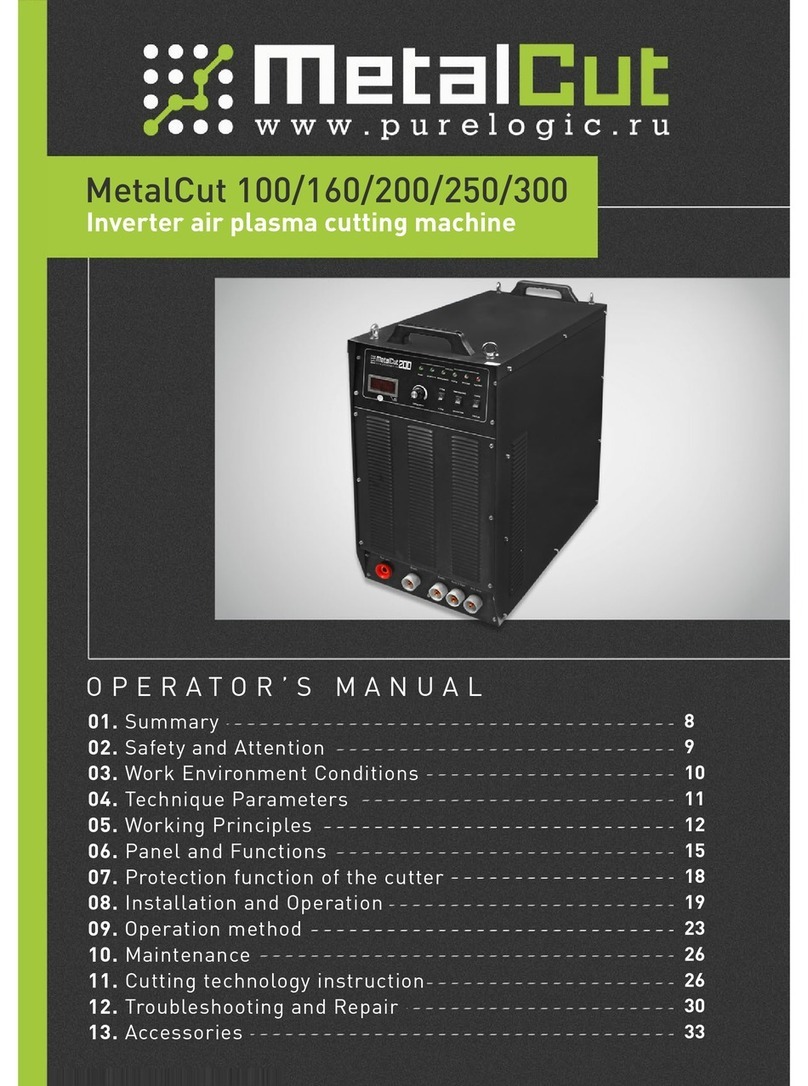
Purelogic
Purelogic MetalCut 100 Operator's manual
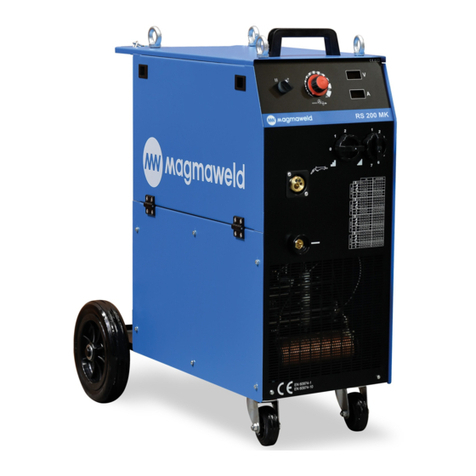
Magmaweld
Magmaweld RS 200 MK user manual
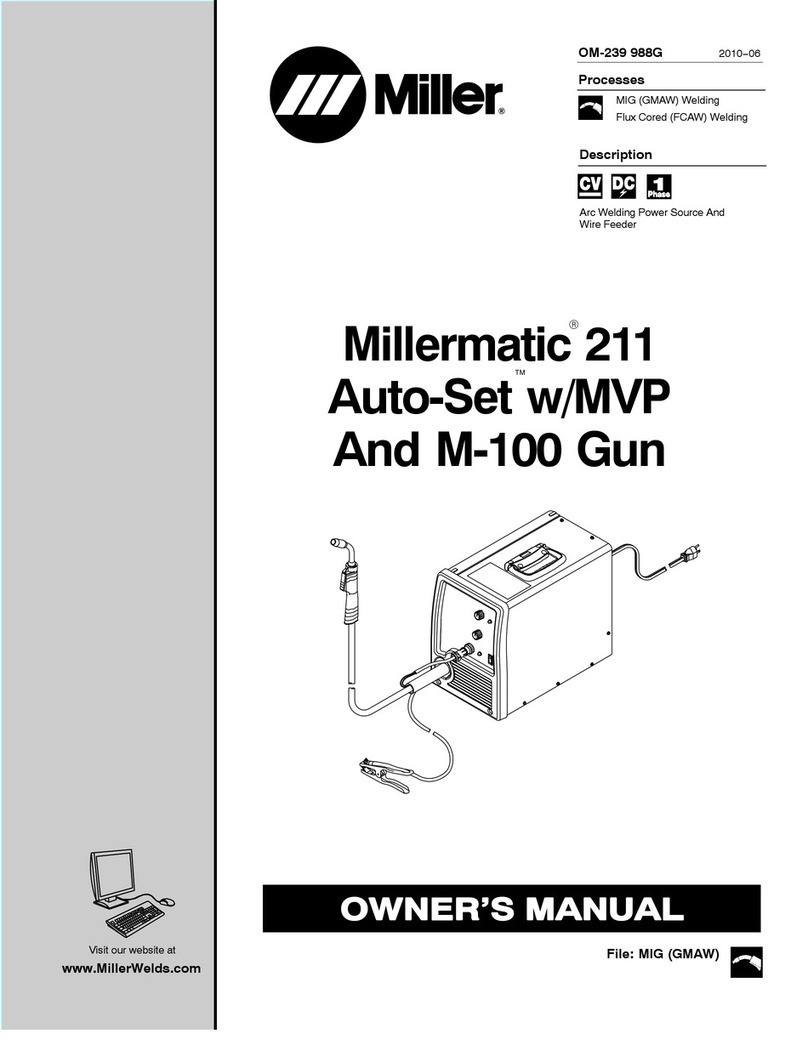
Miller
Miller Millermatic 211 Auto-Set owner's manual
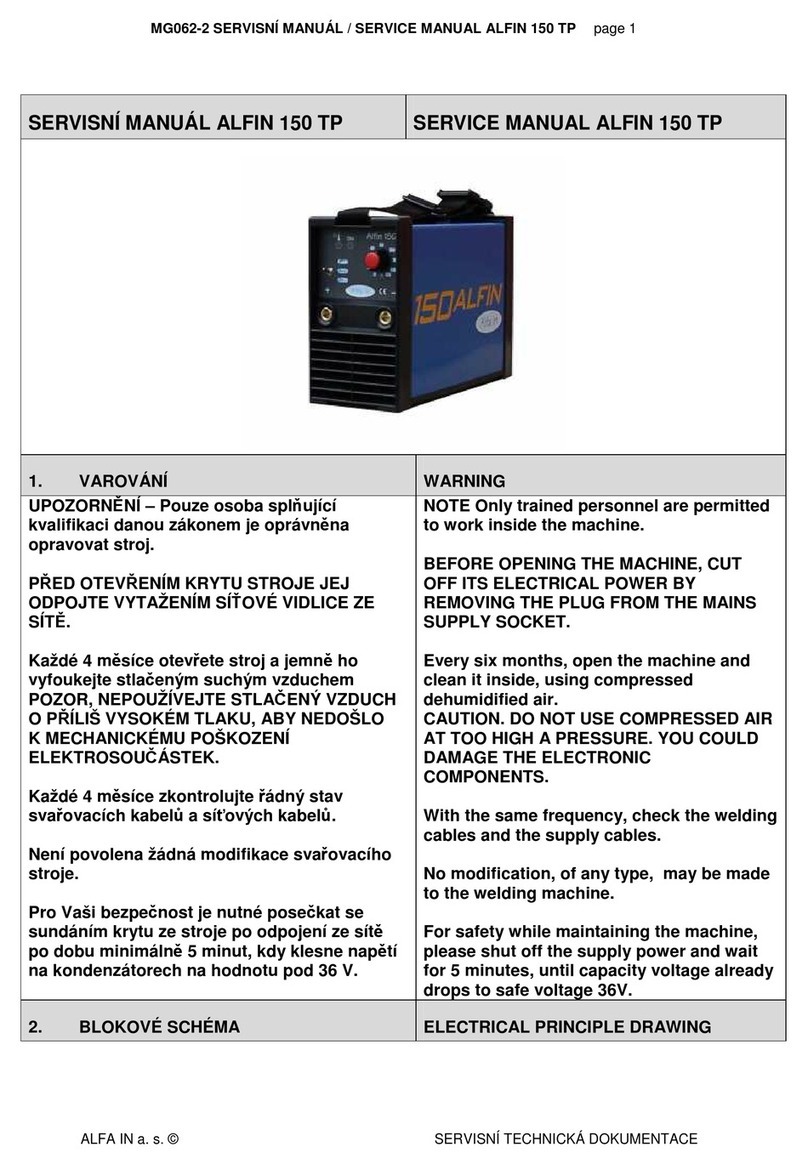
ALFIN
ALFIN 150 TP Service manual

Lincoln Electric
Lincoln Electric Infinity-Pak K3926-1 Operator's manual
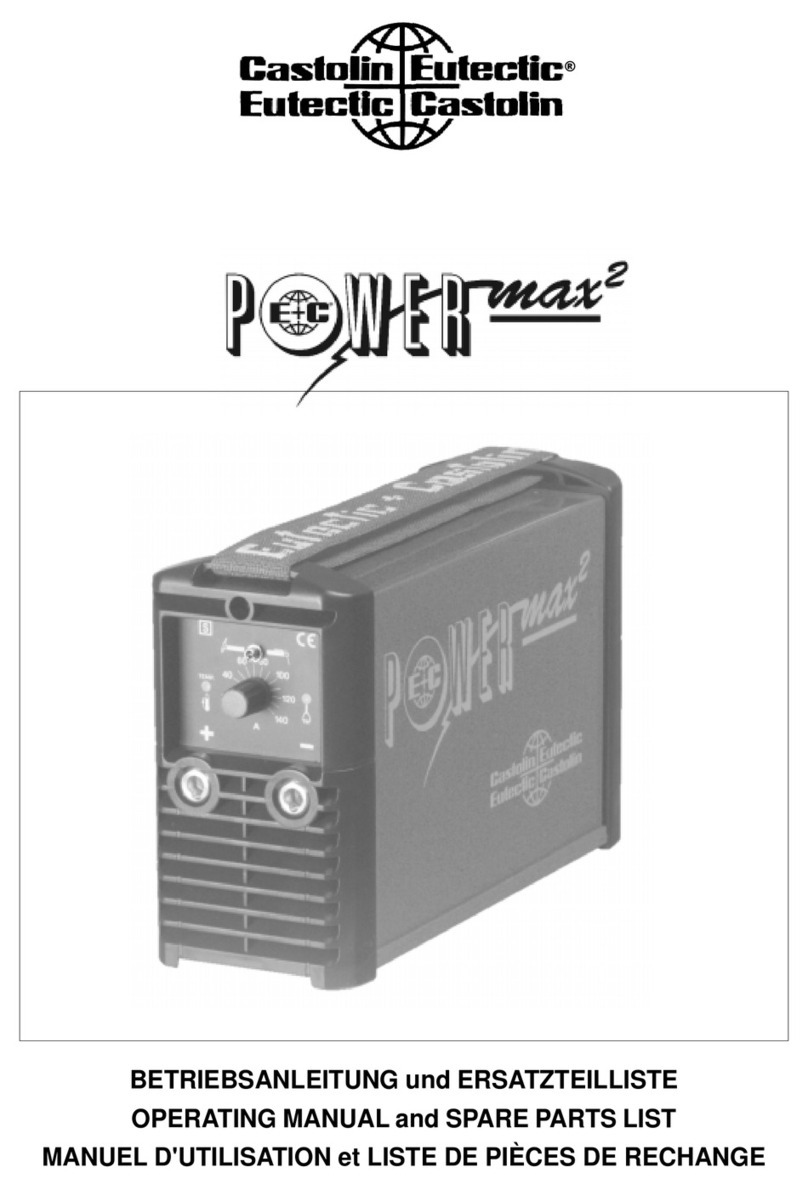
Castolin Eutectic
Castolin Eutectic POWERmax2 Operating manual and Spare parts list





